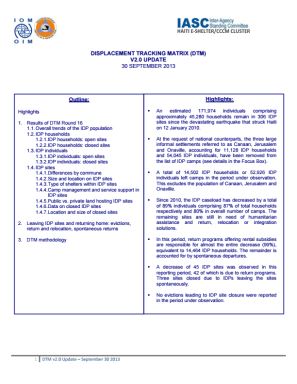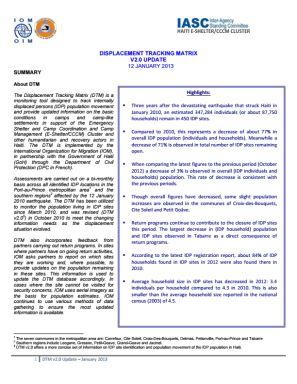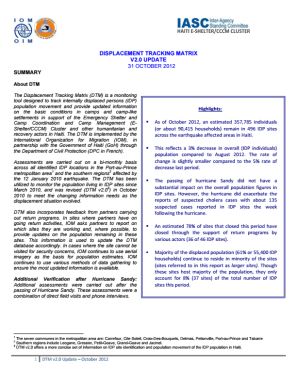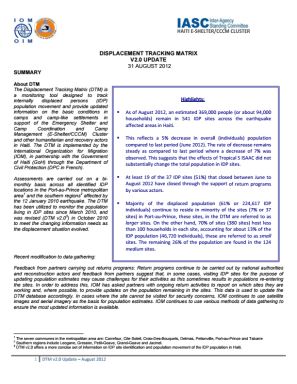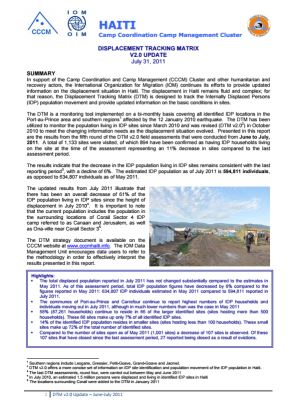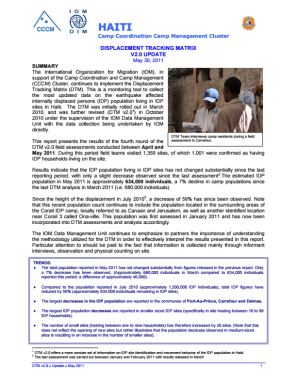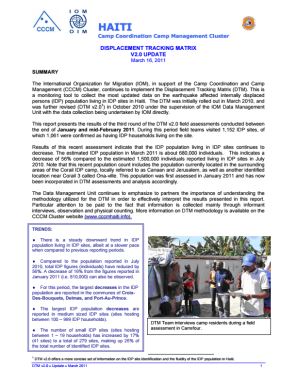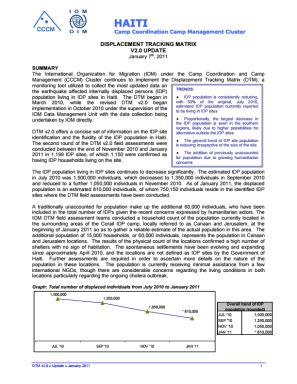-
Countries
-
Data and Analysis
-
Special Focus
-
Crisis Responses
Haiti
Desplazados internos rastreados
Movimientos de desplazamiento
311,000
IDMC 2023
Ronda de recopilación de datos
Sobre Haiti
On January 12th 2010, an earthquake of 7.0 magnitude hit Haiti, resulting in the destruction of more than 300,000 buildings and the displacement of 1.5 million people. Following this destructive earthquake, and as the lead Camp Coordination/Camp Management agency, IOM took the initiative to develop a unified displacement data management process, called the Displacement Tracking Matrix (DTM). A comprehensive multi-sectoral tracking system was applied as a monitoring tool to track the IDP population on basic conditions in IDP sites, and camp-like settlements in support of the Emergency Shelter and Camp Coordination and Camp Management (E-Shelter/CCCM) Cluster and other humanitarian and recovery actors in Haiti. IOM implements the DTM in partnership with the Government of Haiti (GoH) through the Directorate of Civil Protection (DPC in French).
DTM has been adapted to the new context in the country to track humane mobility including displacement induced by gangs violence, forced returns of Haitians, migration with country in the region, especially with the Dominican Republic.
Current Donors
- CERF
- USAID
- BHA
- ECHO
- Canada
Para obtener resultados de búsqueda más avanzados, vaya a la Página de búsqueda avanzada de informes
Haiti — Earthquake Displacement Report 20 (September 2014)
123 sites remain open, corresponding to 22,741 households or 85,432 individuals.
Haiti — Earthquake Displacement Report 19 (June 2014)
172 sites remain open, corresponding to 28,134 households or 103,565 individuals. A decrease of 33,978 IDP individuals, or 8,997 IDP households was recorded; corresponding to a 24.7% decrease in the number of individuals and 24.2% decrease in the number of households, respectively.
Haiti — Earthquake Displacement Report 18 (April 2014)
243 sites remain open corresponding to 37,131 households or 137,543 individuals. Compared to the previous assessments, a decrease of 9,382 IDP individuals or 2,439 IDP households was recorded.
Haiti — Earthquake Displacement Report 17 (January 2014)
Four years after the devastating earthquake that struck Haiti in January 2010, an estimated 146,573 individuals (comprising approximately 39,464 households) remain in 271 IDP sites.
Haiti — Earthquake Displacement Report 16 (September 2013)
An estimated 171,974 individuals comprising approximately 45,280 households remain in 306 IDP sites since the devastating earthquake that struck Haiti on 12 January 2010.
Haiti — Earthquake Displacement Report 15 (June 2013)
Three and a half years after the devastating earthquake that struck Haiti in January 2010, an estimated 278,945 individuals (or about 70,910 households) remain in 352 IDP sites.
Haiti — Earthquake Displacement Report 14 (March 2013)
More than 3 years after the devastating earthquake that struck Haiti in January 2010, an estimated 320,051 individuals (or about 81,349 households) remain in 385 IDP sites.
Haiti — Earthquake Displacement Report 13 (January 2013)
Three years after the devastating earthquake that struck Haiti in January 2010, an estimated 347,284 individuals (or about 87,750 households) remain in 450 IDP sites. Compared to 2010, this represents a decrease of about 77% in overall IDP population (individuals and households).
Haiti — Earthquake Displacement Report 12 (October 2012)
As of October 2012, an estimated 357,785 individuals (or about 90,415 households) remain in 496 IDP sites across the earthquake affected areas in Haiti. This reflects a 3% decrease in overall (IDP individuals) population compared to August 2012.
Haiti — Earthquake Displacement Report 11 (August 2012)
As of August 2012, an estimated 369,000 people (or about 94,000 households) remain in 541 IDP sites across the earthquake affected areas in Haiti. This reflects a 5% decrease in overall (individuals) population compared to last period (June 2012).
Haiti — Earthquake Displacement Report 10 (June 2012)
A total of 575 sites hosting 97,913 IDP households or 390,276 IDP individuals remain open across the earthquake affected area. Compared to the previous report (April 2012), a 7% decrease in IDP individual population is observed.
Haiti — Earthquake Displacement Report 9 (April 2012)
Compared to the previous report (February 2012), a 14% decrease in IDP individual population is observed. This rate of decrease is the largest observed since March 2011.
Haiti — Earthquake Displacement Report 8 (February 2012)
Total number of IDPs living in IDP sites is now less than 500,000. Specifically: there are about 490,545 IDP individuals (or 120,791 IDP households) remaining in 660 IDP sites in the earthquake affected areas.
Haiti — Earthquake Displacement Report 7 (November 2011)
Compared to the height of displacement in July 2010, the total IDP population (individuals) this period shows a 66% decrease: from 1,500,000 in July 2010 to 520,000 in November 2011.
Haiti — Earthquake Displacement Report 6 (September 2011)
The total displaced population in September 2011 has not changed substantially compared to the previous period, only a decrease of 9% is observed: 149,317 IDP households estimated in July 2011 compared to 135,961 reported in September 2011.
Haiti — Earthquake Displacement Report 5 (July 2011)
The total displaced population reported in July 2011 has not changed substantially compared to the estimates in May 2011.
Haiti — Earthquake Displacement Report 4 (May 2011)
The total population reported in May 2011 has not changed substantially from figures released in the previous report. Only a 7% decrease has been observed. (Approximately 680,000 individuals in March compared to 634,000 individuals reported this period: a difference of approximately 46,000).
Haiti — Earthquake Displacement Report 3 (March 2011)
There is a steady downward trend in IDP population living in IDP sites, albeit at a slower pace when compared to previous reporting periods. Compared to the population reported in July 2010, total IDP figures (individuals) have reduced by 56%.
Haiti — Earthquake Displacement Report 2 (January 2011)
The IDP population is consistently reducing, with 50% of the originally displaced in July 2010, currently reported to be living in IDP sites.
Haiti — Earthquake Displacement Report 1 (December 2010)
Between the 25 October and 30 November, DTM field assessments were conducted in 1,356 IDP sites, of which 1,199 were confirmed as having IDP households living on the site.
Pagination
- First page
- Previous page
- …
- 3
- 4
- 5
- 6
- 7
- 8
- 9
- 10
- 11
Para obtener resultados de búsqueda más avanzados, vaya a la Página de búsqueda avanzada de informes
Pagination
- First page
- Previous page
- 1
- 2
- 3
- 4
- 5
- 6
- 7
- 8
Para obtener resultados de búsqueda más avanzados, vaya a la Página de búsqueda avanzada de conjuntos de datos






